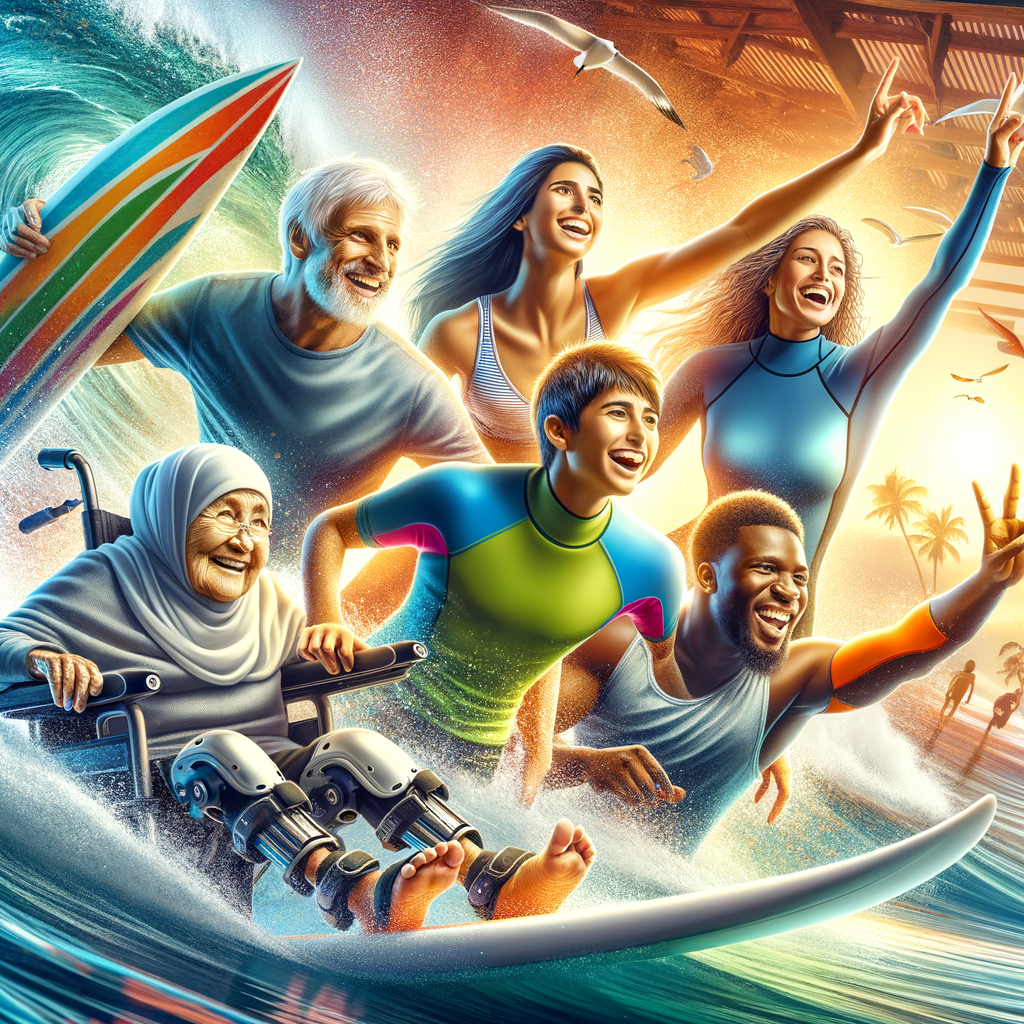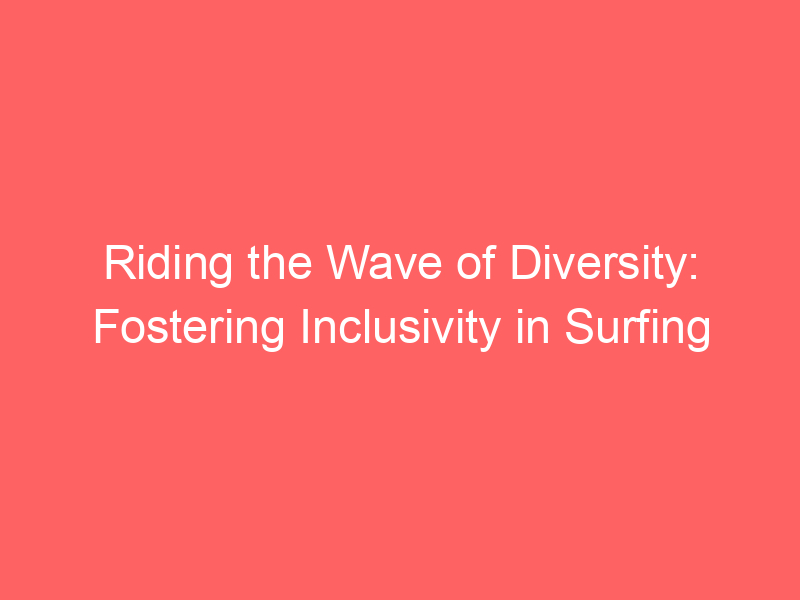
Introduction: The Current State of Surfing Diversity
Surfing, a sport that has been around for centuries, is known for its rich culture and community. However, like many other sports, it has faced challenges in terms of diversity and inclusion. This article aims to shed light on the current state of diversity in surfing and the challenges faced by underrepresented groups.
- Overview of diversity in surfing
- Challenges faced by underrepresented groups in surfing
Surfing has traditionally been dominated by white, male athletes. However, the face of surfing is slowly changing. According to a Wikipedia article, the number of women surfers has been steadily increasing, and there is a growing recognition of the talent and skill of surfers from diverse backgrounds. Despite this progress, there is still a long way to go. The representation of people of color, LGBTQ+ individuals, and people with disabilities in surfing is still significantly low.
Underrepresented groups in surfing face numerous challenges. These include lack of access to surfing equipment and facilities, lack of representation in media and competitions, and discrimination and bias. For example, a Wikipedia article highlights that surfers of color often face racial discrimination and are underrepresented in professional surfing. Similarly, women surfers often face gender bias and are paid less than their male counterparts.
Understanding these challenges is the first step towards promoting diversity and inclusion in surfing. The following sections will delve deeper into the importance of inclusive surfing, practical steps to encourage diversity, and the role of surfing equipment manufacturers in promoting diversity.
Understanding the Importance of Inclusive Surfing
Surfing, like many other sports, has traditionally been dominated by a certain demographic. However, the importance of inclusivity in surfing cannot be overstated. Inclusivity not only enriches the sport by bringing in diverse perspectives and experiences, but it also fosters a sense of community and belonging among all participants.
- The benefits of diversity in water sports
Diversity in water sports, including surfing, has numerous benefits. It promotes a sense of unity and understanding among participants from various backgrounds. It also encourages creativity and innovation, as different people bring unique styles and techniques to the sport.
Moreover, diversity in surfing can help to break down barriers and stereotypes. For instance, it can challenge the notion that surfing is only for those with a certain body type or physical ability. With more diverse representation, we can show that surfing is truly a sport for everyone.
- How inclusivity can change the surf culture
Inclusivity can significantly change the surf culture for the better. It can make the sport more welcoming and accessible to people from all walks of life. This can lead to a more vibrant and diverse surf community, where everyone feels valued and included.
Furthermore, inclusivity can help to broaden the appeal of surfing. By making the sport more inclusive, we can attract a wider range of participants. This can help to grow the sport and ensure its sustainability for the future.
In conclusion, inclusivity in surfing is not just about fairness or equality. It’s about enriching the sport and making it more vibrant, welcoming, and sustainable. So let’s embrace diversity and inclusivity in surfing, and see the positive changes it can bring.
Encouraging Diversity in Surfing: Practical Steps
One of the most effective ways to encourage diversity in surfing is by creating inclusive surfing programs. These programs are designed to welcome everyone, regardless of their background, age, or ability.
Creating Inclusive Surfing Programs
Creating inclusive surfing programs is not just about opening the doors to everyone. It’s about making sure that everyone feels welcomed, supported, and valued. Let’s take a look at some examples of successful inclusive surfing programs and the key takeaways from these programs.
- Examples of successful inclusive surfing programs
- Key takeaways from these programs
One example of a successful inclusive surfing program is the Surfers Healing program. This program is specifically designed for children with autism, providing them with a safe and supportive environment to learn and enjoy surfing. Another example is the Black Girls Surf program, which aims to increase the representation of black women in professional surfing.
There are several key takeaways from these programs. First, they show that surfing can be a sport for everyone, regardless of their background or ability. Second, they demonstrate the importance of creating a supportive and inclusive environment. Lastly, they highlight the need for representation in the sport, showing that everyone can be a surfer and a role model.
In conclusion, creating inclusive surfing programs is a practical step towards encouraging diversity in surfing. By learning from successful programs and implementing their key takeaways, we can make surfing a more inclusive and diverse sport.
Promoting Inclusivity in Surfing Through Education
Education plays a significant role in promoting inclusivity in any field, and surfing is no exception. By educating individuals about the importance of diversity in surfing, we can foster a more inclusive environment that welcomes everyone, regardless of their background or abilities.
- The Role of Education in Fostering Diversity in Surfing
- Case Studies of Educational Initiatives Promoting Surfing Inclusivity
- Surfing for All: This initiative aims to make surfing accessible to everyone, regardless of their physical abilities. They offer adaptive surfing lessons and have successfully introduced the sport to many individuals with disabilities. Learn more about adaptive surfing here.
- Diversity in Waves: This program focuses on promoting diversity in surfing by highlighting the achievements of surfers from different backgrounds. They offer educational resources and workshops to foster a more inclusive surfing community.
Education is a powerful tool in fostering diversity in surfing. It helps break down barriers and misconceptions that may prevent certain groups from participating in the sport. By educating the public about the benefits of surfing and the importance of inclusivity, we can encourage more people to take up the sport, thereby increasing diversity.
For instance, educational programs can highlight the achievements of diverse surfers, showing that anyone can excel in the sport. They can also provide information on adaptive surfing for individuals with disabilities, promoting inclusivity.
Several educational initiatives have been successful in promoting surfing inclusivity. Let’s look at a couple of examples:
Through education, we can create a more inclusive surfing community that welcomes and celebrates diversity. By highlighting the achievements of diverse surfers and providing resources for adaptive surfing, we can encourage more people to participate in this wonderful sport.
Surfing for All: The Role of Surfing Equipment Manufacturers
Surfing equipment manufacturers play a critical role in promoting inclusivity in water sports. They have the power to create products that cater to a diverse range of individuals, regardless of their physical abilities, age, or experience level. By doing so, they can help make surfing more accessible and enjoyable for everyone.
- How manufacturers can contribute to encouraging inclusivity in water sports
- Examples of inclusive surfing equipment
Manufacturers can contribute to inclusivity in several ways. First, they can design and produce equipment that caters to different body types and physical abilities. For example, larger surfboards can be made for beginners or those with mobility issues, while smaller, lighter boards can be made for younger or less physically strong individuals.
Second, manufacturers can promote diversity in their marketing campaigns. By featuring surfers of different ages, genders, and ethnic backgrounds in their advertisements, they can help to normalize diversity in the sport and inspire a wider range of people to take up surfing.
Finally, manufacturers can partner with organizations that promote inclusivity in water sports, such as International Surfing Association. These partnerships can help to raise awareness about the importance of diversity and inclusivity in surfing, and provide resources and support for those who are underrepresented in the sport.
There are many examples of inclusive surfing equipment on the market today. For instance, longboards are great for beginners and those with mobility issues, as they provide more stability and are easier to paddle and stand up on than shorter boards.
Another example is the use of soft-top surfboards, which are safer and more forgiving for beginners. They are less likely to cause injury if a surfer falls off or gets hit by the board.
Finally, there are also adaptive surfboards designed specifically for individuals with physical disabilities. These boards often come with special features like handles and straps, and can be customized to suit the individual’s needs.
In conclusion, surfing equipment manufacturers have a significant role to play in promoting inclusivity in water sports. By designing and producing inclusive equipment, and by promoting diversity in their marketing and partnerships, they can help to make surfing a sport that truly is for everyone.
Conclusion: The Future of Surf Culture Diversity
As we wrap up our discussion on the diversity in surf culture, it’s essential to look at the current trends and make some predictions about the future. The world of surfing, like many other sports, is continuously evolving, and diversity is one of the key areas where we see significant changes.
- Current trends in surfing diversity
Surfing has traditionally been dominated by males, but the tide is turning. More and more women are taking up the sport, and we’re seeing a rise in the number of professional female surfers. According to Wikipedia, the number of female surfers worldwide has increased by 35% over the past decade.
Additionally, we’re seeing a greater representation of different races and ethnicities in the sport. Surfing organizations are making concerted efforts to promote diversity and inclusion, and it’s paying off. Surfing is becoming a truly global sport, with surfers of all backgrounds making their mark.
- Predictions for the future of inclusive water sports
Looking ahead, we can expect the trend of increased diversity in surfing to continue. As more people from different backgrounds discover the joy of surfing, the sport will become even more inclusive. We predict that in the future, we’ll see a more balanced gender ratio in professional surfing, and even greater representation of different races and ethnicities.
Furthermore, we anticipate that adaptive surfing, which allows people with disabilities to participate in the sport, will gain more recognition and support. This will make surfing truly a sport for all, regardless of physical ability.
In conclusion, the future of surf culture diversity looks bright. With ongoing efforts to promote inclusion and diversity, we can look forward to a time when everyone, regardless of their background or ability, can enjoy the thrill of riding the waves.
Additional Resources
If you’re interested in learning more about diversity in water sports and how to promote inclusivity in surfing, there are many resources available. Here are some organizations and materials that can provide further information and insights.
- Organizations Promoting Diversity in Water Sports
- Brown Girl Surf – This organization aims to increase the visibility and participation of women of color in surfing.
- Black Girls Surf – An organization that supports young girls of African descent who aspire to become professional surfers.
- Surfers Healing – A non-profit organization that provides free surf camps for children with autism.
- Books and Documentaries on Surfing Inclusivity
- “Barbarian Days: A Surfing Life” by William Finnegan – A Pulitzer Prize-winning memoir that explores the author’s experiences with surfing across the globe.
- “Surf Girl Roxy” by Natalie Linden – This book highlights the experiences of female surfers and the importance of inclusivity in the sport.
- “Under an Arctic Sky” – A documentary that follows six surfers as they journey to the most remote corners of Iceland in the middle of winter in search of perfect waves.
There are several organizations that are dedicated to promoting diversity in water sports. They work towards making water sports more accessible and inclusive for everyone, regardless of their race, gender, or socioeconomic status.
There are also many books and documentaries that explore the topic of surfing inclusivity. These resources provide a deeper understanding of the challenges and triumphs of diverse groups in the surfing world.








